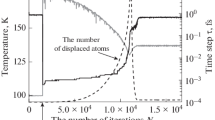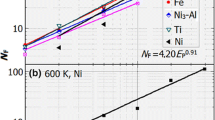Abstract
In this paper, radiation defects in bcc molybdenum with the primary knock-on atom (PKA) energies of 2–40 keV are simulated by the molecular dynamics. The binding energy of single point defect-to-defect clusters increases with the cluster size. The stability and mobility of point defects and defect clusters are analyzed. The interstitial-type clusters are found to be easily migrating along the <111> direction with low barriers (0.01–0.10 eV). Then, the object kinetic Monte Carlo is used to gain insight into the long-term defect evolution in the cascade. The simulation results indicate that Stage I almost occurs at annealing temperature of 100 K, which corresponds to the correlated recombination resulting from the motion of small interstitial clusters (n ≤ 2). The formation of substage partly as result of the small vacancy clusters motion. At about 460 K, the Stage II starts because of uncorrelated recombination due to an emitting mechanism of larger clusters. Size distribution of the clusters at the cascade quenching stage is positively correlated with the PKA energies, affecting notably the subsequent annealing process.







Similar content being viewed by others
References
P. Yvon, F. Carré, Structural materials challenges for advanced reactor systems. J. Nucl. Mater. 385, 217–222 (2009). doi:10.1016/j.jnucmat.2008.11.026
C. Jun, B.X. Xiao, C. Kun et al., Analysis on reactivity initiated transient from control rod failure events of a molten salt reactor. Nucl. Sci. Tech. 25, 030602 (2014). doi:10.13538/j.1001-8042/nst.25.030602
A.A.F. Tavassoli, Present limits and improvements of structural materials for fusion reactors. J. Nucl. Mater. 302, 73–88 (2002). doi:10.1016/S0022-3115(02)00794-8
P. Feng, S.Y. Liu, B. Wei et al., Simulation and experimental study of a random neutron analyzing system with 252Cf neutron source. Nucl. Sci. Tech. 22(1), 39–46 (2011). doi:10.13538/j.1001-8042/nst.22.39-46
T. Jun, J.X. Li, L.L. Tong et al., Core cooling in pressurized-water reactor during water injection. Nucl. Sci. Tech. 22(1), 60–64 (2011). doi:10.13538/j.1001-8042/nst.22.60-64
Q. Han, Q.S. Wu, J.W. Chen et al., Analysis of fixation method of fuel assembly for lead-alloy cooled reactor. Nucl. Sci. Technol. 26(5), 50601 (2015). doi:10.13538/j.1001-8042/nst.26.050601
G.D. Temmerman, M.J. Baldwin, R.P. Doerner et al., Beryllium deposition on international thermonuclear experimental reactor first mirrors: layer morphology and influence on mirror reflectivity. J. Appl. Phys. 102, 083302 (2007). doi:10.1063/1.2798389
T. Sugie, S. Kasai, M. Taniguchi et al., Irradiation test of Mo- and W-mirrors for ITER by low energy deuterium ions. J. Nucl. Mater. 329–333, 1481–1485 (2004). doi:10.1016/j.jnucmat.2004.04.248
B.V. Cockeram, J.L. Hollenbeck, L.L. Snead, The change in tensile properties of wrought LCAC molybdenum irradiated with neutrons. J. Nucl. Mater. 324, 77–89 (2004). doi:10.1016/j.jnucmat.2003.05.001
M.M. Li, M. Eldrup, T.S. Byun et al., Low temperature neutron irradiation effects on microstructure and tensile properties of molybdenum. J. Nucl. Mater. 376, 11–28 (2008). doi:10.1016/j.jnucmat.2007.12.001
D. Yun, M.A. Kirk, P.M. Baldo et al., In situ TEM investigation of Xe ion irradiation induced defects and bubbles in pure molybdenum single crystal. J. Nucl. Mater. 437, 240–249 (2013). doi:10.1016/j.jnucmat.2013.01.305
D.H. Xu, B.D. Wirth, M.M. Li et al., Defect micro-structural evolution in ion irradiated metallic nano-foils: Kinetic Monte Carlo simulation versus cluster dynamics modeling and in situ transmission electron microscopy experiments. Appl. Phys. Lett. 101, 101905 (2012). doi:10.1063/1.4748980
M. Eldrup, M.M. Li, L.L. Snead et al., Characterization of defect accumulation in neutron-irradiated Mo by positron annihilation spectroscopy. Nucl. Instrum. Methods B 266, 3602–3606 (2008). doi:10.1016/j.nimb.2008.06.018
A.Y. Kuksin, G.E. Norman, V.V. Stegailov et al., Radiation-induced damage and evolution of defects in Mo. Phys. Rev. B 84, 104109 (2011). doi:10.1103/PhysRevB.84.104109
S. Han, L.A. Zepeda-Ruiz, G.J. Ackland et al., Self-interstitials in V and Mo. Phys. Rev. B 66, 220101 (2002). doi:10.1103/PhysRevB.66.220101
Young, F.W and Jr., What do we really know about the atomic-scale structures of nanophase materials. J. Nucl. Mater. 310, 69–70 (1978). doi:10.1016/0022-3697(94)90127-9
D.N. Manh, A.P. Horsfield, S.L. Dudarev, Self-interstitial atom defects in bcc transition metals: Group-specific trends. Phys. Rev. B 73, 020101 (2006). doi:10.1103/PhysRevB.73.020101
A.F. Calder, D.J. Bacon, A.V. Barashev et al., On the origin of large interstitial clusters in displacement cascades. Philos. Mag 863, 90 (2010). doi:10.1080/14786430903117141
A.P. Selby, D.H. Xu, N. Juslin et al., Primary defect production by high energy displacement cascades in molybdenum. J. Nucl. Mater. 437, 19–23 (2013). doi:10.1016/j.jnucmat.2013.01.332
F. Gao, D.J. Bacon, A.V. Barashev et al., Modeling the long-term evolution of the primary damage in ferritic alloys using coarse-grained methods. Mat. Res. Soc. Symp. Proc 540, 703–708 (1999). doi:10.1016/j.jnucmat.2010.05.019
T. Suzudo, S.I. Golubov, R.E. Stoller et al., Annealing simulation of cascade damage in α-Fe—Damage energy and temperature dependence analyses. Proc. Nucl. Sci. Tech. 2, 56–63 (2011). doi:10.1016/j.jnucmat.2012.01.014
H.L. Heinisch, B.N. Singh, Stochastic annealing simulation of intracascade defect interactions. J. Nucl. Mater. 251, 77–85 (1997). doi:10.1016/S0022-3115(97)00219-5
A. Almazouzi, M.J. Caturla, T.D. Rubia et al., Annealing kinetics of single displacement cascades in Ni: an atomic scale computer simulation. Mat. Res. Soc. Symp. Proc 540, 685–690 (1999). doi:10.1557/PROC-540-685
Z.W. Rong, F. Gao, W.J. Weber, Monte Carlo simulations of defect recovery within a 10 keV collision cascade in 3C–SiC. J. Appl. Phys 102, 103508 (2007). doi:10.1063/1.2812701
H.L. Heinisch, B.N. Singh, Stochastic annealing simulation of differential defect production in high energy cascades. J. Nucl. Mater. 232, 206–213 (1996). doi:10.1016/S0022-3115(96)00434-5
K. Wang, H.Q. Deng, W.Y. Hu et al., An atomic study on the shock-induced plasticity and phase transition for iron-based single crystals. Int. J. Plast 59, 180–198 (2014). doi:10.1016/j.ijplas.2014.03.007
N.W. Hu, S.F. Xiao, H.Q. Deng et al., Molecular dynamics simulation of displacement cascades in Ni–Mo alloy. Nucl. Sci. Tech. 26, 060603 (2015). doi:10.13538/j.1001-8042/nst.26.060603
P. Maragakis, S.S.A. Andreev, Y. Brumer et al., Adaptive nudged elastic band approach for transition state calculation. J. Chem. Phys 117, 4651 (2002). doi:10.1063/1.1495401
J.W. Chu, B.L. Trout, B.R. Brooks, A super-linear minimization scheme for the nudged elastic band method. J. Chem. Phys 119, 12708 (2003). doi:10.1063/1.1627754
G. Henkelman, B.P. Uberuaga, H. Jo´nsson, A climbing image nudged elastic band method for finding saddle points and minimum energy paths. J. Chem. Phys 113, 9901 (2000). doi:10.1063/1.1329672
C.S. Becquart, C. Domain, An object kinetic Monte Carlo Simulation of the dynamics of helium and point defects in tungsten. J. Nucl. Mater. 385, 223–227 (2009). doi:10.1016/j.jnucmat.2008.11.027
G.J. Galloway, G.J. Ackland, Molecular dynamics and object kinetic Monte Carlo study of radiation-induced motion of voids and He bubbles in bcc iron. Phys. Rev. B 87, 104106 (2013). doi:10.1103/PhysRevB.87.104106
R.E. Stoller, S.I. Golubov, C. Domain et al., Mean field rate theory and object kinetic Monte Carlo: a comparison of kinetic models. J. Nucl. Mater. 382, 77–90 (2008). doi:10.1016/j.jnucmat.2008.08.047
J. Yang, Y. Yang, Y. Li et al., Monte-Carlo simulation of cement neutron field distribution characteristics in PGNAA. Nucl. Sci. Tech. 6, 006 (2012). doi:10.13538/j.1001-8042/nst.23.337-343
L. Gámez, B. Gámez, M.J. Caturla et al., Object Kinetic Monte Carlo calculations of irradiated Fe–Cr dilute alloys: the effect of the interaction radius between substitutional Cr and self-interstitial Fe. Nucl. Instrum. Methods B 269, 1684–1688 (2011). doi:10.1016/j.nimb.2010.12.044
C. Domain, C.S. Becquart, L. Malerba, Simulation of radiation damage in Fe alloys: an object kinetic Monte Carlo approach. J. Nucl. Mater. 335, 121–145 (2004). doi:10.1016/j.jnucmat.2004.07.037
T. Suzudo, S.I. Golubov, R.E. Stoller et al., Kinetic Monte Carlo annealing simulation of cascade damage in α-Fe. Pro. Nuc. Sci. Tec 2, 56–63 (2011). doi:10.15669/pnst.2.56
H.X. Xu, Y.N. Osetsky, R.E. Stoller, Cascade annealing simulations of bcc iron using object kinetic Monte Carlo. J. Nucl. Mater. 423, 102–109 (2012). doi:10.1016/j.jnucmat.2012.01.020
C.C. Fu, J.D. Torre, F. Willaime et al., Multiscale modelling of defect kinetics in irradiated iron. Nat. Mat. 4, 68–74 (2005). doi:10.1038/nmat1286
D.J. Bacon, F. Gao, Y.N. Osetsky, Computer simulation of displacement cascades and the defects they generate in metals. Nucl. Instrum. Methods B 153, 87–98 (1999). doi:10.1016/S0168-583X(99)00041-5
R.A. Johnson, Interstitials and vacancies in α iron. Phys. Rev. 134, 5 (1964). doi:10.1103/PhysRev.134.A1329
G.J. Galloway, G.J. Ackland, Molecular dynamics and object kinetic Monte Carlo study of radiation-induced motion of voids and He bubbles in bcc iron. Phys. Rev. B 87, 104106 (2013). doi:10.1103/PhysRevB.87.104106
Author information
Authors and Affiliations
Corresponding author
Additional information
This work was supported by the Shanghai Municipal Science and Technology Commission (No. 13ZR1448000) and the National Natural Science Foundation of China (No. 11505266).
Rights and permissions
About this article
Cite this article
Wu, GY., Hu, NW., Deng, HQ. et al. Simulation of radiation damages in molybdenum by combining molecular dynamics and OKMC. NUCL SCI TECH 28, 3 (2017). https://doi.org/10.1007/s41365-016-0164-9
Received:
Revised:
Accepted:
Published:
DOI: https://doi.org/10.1007/s41365-016-0164-9




